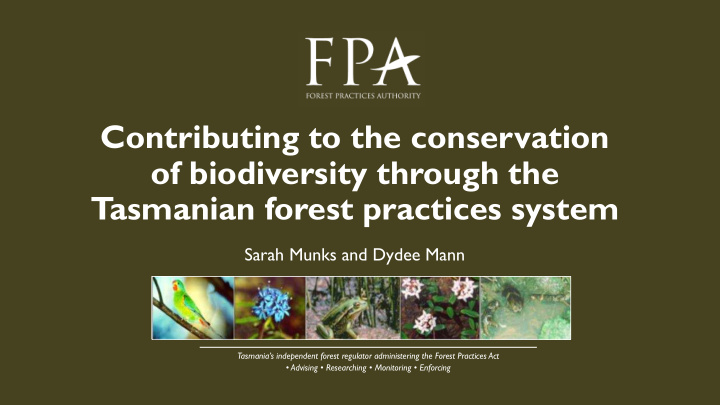



Contributing to the conservation of biodiversity through the Tasmanian forest practices system Sarah Munks and Dydee Mann Tasmania’s independent forest regulator administering the Forest Practices Act • Advising • Researching • Monitoring • Enforcing
Three tiered conservation approach Comprehensive, Adequate, Representative (CAR) reserve system Permanent native forest estate ‘Off-reserve’ management actions Caleana major
Core ranges: Core ranges: Invertebrates (blue) Vertebrates (green) Threatened plant Threatened records forest Raptor nests communities CAR Reserves
Guiding P Policy f for t the operation o of the Forest Pract ctice ces Co Code ( de ( established under the Forest Practices Act 1985 ) 8.8. Biodiversity Forest practices will be conducted in a manner that recognises and complements the contribution of the reserve system to the maintenance of biological diversity, ecological function and evolutionary processes through the maintenance of viable breeding populations and habitat for all species.
The Biodiversity Evaluation: A ‘Risk Assessment’ Process 1. Identification of the value – databases and survey 2. Consideration of disturbance risk 3. Assess significance of the impact 4. Decision on ways to mitigate the impact
Identification of the value - Planning tools
On-ground survey - vegetation community, species and habitat
Landscape level management actions Native forest only Plantation Formal reserve Informal reserve Simsons range Roads
Coupe level management actions
The Code – threatened species and communities D3.3 ‘ Threatened species and threatened native vegetation communities will be managed in accordance with procedures agreed between the FPA and DPIPWE. The agreed procedures will include the development of endorsed management prescriptions through consultation among landowners, FPOs and specialists within the FPA and DPIPWE.’
Threatened communities and species • 39 threatened vegetation communities (listed on State and/or C’wealth Acts) • 113 threatened fauna (out of 240 listed on State and C’wealth Acts) • 349 threatened flora (out of 500 listed species) Diuris palustris Brunonia australis
Decision support systems- Threatened Fauna Adviser
Duty of care provision of the Code – A ‘line in the sand’ “The code is more what you’d call ‘guidelines’ than actual rules.” (Hector Barbossa)
The Biodiversity Landscape Planning Guideline – Property/forest block plans? A guideline which can be used to develop landscape scale strategic plans (e.g. whole of property, forest blocks on public land).
Training
Research and Effectiveness Monitoring Program
From Science to Practice… Publications Planning tools Cawthen, L, Munks, S, Richardon, A and Nicol, SC 2009. EMR 10 (2), 155-157.* Koch, AJ; Munks, SA and Driscoll DA 2008, WR 35: 727–746.* Koch AJ, Wapstra M, and Munks, SA 2009, TBR 33, 4-9.* Koch, AJ, Munks, SA, and Woehler, EJ 2009. AJZ, 56: 323–349.* Munks, SA, Koch, AJ and Wapstra, M 2009, FEM 258: 516-524. Koch, A.J., Baker, S., 2011. Biodiversity and Conservation 20, 1089-1101. Flynn, EM, Jones, SM, Jones, ME, Jordan, GJ and Munks, SA 2011, Wildlife Research, 2011, 38, pp 13–29. Cawthen and Munks, 2011. WR
Case study..
Devils in plantations Norske skog identified caves in use July 2014 and contacted FPA for advice
FPA’s initial investigation of cave Full pouch Empty pouch Evidence of a maternal devil den!
Design of devil-specific site management Consultation between Norske skog/FPA/species experts Recommendations including: 1. Prevent collapse of the cave • Machinery exclusion on cave area • Directional felling of trees away from cave • No replanting of pines within 10m of cave 2. Protect occupants • No harvesting until devil young have dispersed • Speed limit within 100m • No dogs on site
Ongoing monitoring…
60 Pre-harvest - 2014 and 2015 50 40 Number of individuals Feral Cat Rat Spotted tail Quoll Echidna 30 Pademelon Brushtail Possum Eastern Quoll 5 Wombat 4 Tasmanian Devil 20 7 4 9 5 4 4 5 4 10 3 4 3 0 Aug-14 Sep-14 Oct-14 Nov-14 Dec-14 Jan-15 Feb-15 Jul-15 Aug-15 Sep-15 Oct-15 Nov-15 Dec-15
60 Post-harvest 2016 5 50 6 5 40 HARVESTING NEARBY Number of individuals Bennetts Wallaby Feral Cat Rat Spotted tail Quoll Echidna 30 5 2 Pademelon Brushtail Possum HARVESTING OF DEN SITE 2 Eastern Quoll Wombat Tasmanian Devil 20 4 5 4 4 10 1 0 Jan-16 Feb-16 Mar-16 Apr-16 May-16 Jun-16 Jul-16 Aug-16 Sep-16 Oct-16 Nov-16
Post harvest – devils move back in
Summary • The Tasmanian Forest Practices System contributes to conservation of biodiversity values in areas outside of formal reserves • The Code requires that during the preparation of Forest Practices Plans the proposed operational area must be assessed to determine the presence of biodiversity values at risk. • If following the required planning process the risk to a biodiversity value is identified as high, management prescriptions (eg.,‘buffer zones’) are applied and are mandatory. • Targeted, risk-based approach and actions to reduce impacts delivered at multiple spatial scales
Strengths and weaknesses • Strengths • Applies across all land tenures • Scientists, planners and forest managers work together • Planning tools and training – explanatory ‘creep’/streamlining • Commitment to research, monitoring, review and continual improvement • Weaknesses • Lack of knowledge on impact of forest practices • Communication with general public • Lack of clarity and conflicting legislative requirements • Clearance and conversion – Ag developments • No state forest policy or clear overarching objectives • Need more effectiveness monitoring – Do actions work?
Thanks and questions?
Recommend
More recommend